Aelbert Jacobszoon Cuyp or Cuijp (Dutch pronunciation: [ˈɑlbər ˈtɕaːkɔpsoːŋ ˈkœyp]; 20 October 1620 – 15 November 1691) was one of the leading Dutch Golden Age painters, producing mainly landscapes. The most famous of a family of painters, the pupil of his father, Jacob Gerritszoon Cuyp (1594–1651/52), he is especially known for his large views of Dutch riverside scenes in a golden early morning or late afternoon light. He was born and died in Dordrecht.
Biography
Known as the Dutch equivalent of Claude Lorrain, he inherited a considerable fortune. His family were all artists, with his uncle Benjamin and grandfather Gerrit being stained glass cartoon designers. Jacob Gerritszoon Cuyp, his father, was a portraitist. Cuyp's father was his first teacher and they collaborated on many paintings throughout his lifetime.
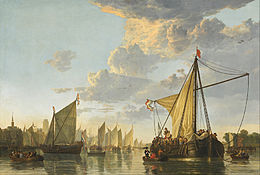
Little is known about Aelbert Cuyp's life. Even Arnold Houbraken, a noted historian of Dutch Golden Age paintings and the sole authority on Cuyp for the hundred years following his death, paints a very thin biographical picture.
His period of activity as a painter is traditionally limited to the two decades between 1639 and 1660, fitting within the generally accepted limits of the Dutch Golden Age's most significant period, 1640–1665. He is known to have been married to Cornelia Bosman in 1658, a date coinciding so directly with the end of his productivity as a painter that it has been accepted that his marriage played a role in the end of his artistic career.
The year after his marriage, Cuyp became the deacon of the reformed church. Houbraken recalled that Cuyp was a devout Calvinist and the fact that when he died, there were no paintings of other artists found in his home.
Style
The development of Cuyp, who was trained as a landscape painter, may be roughly sketched in three phases based on the painters who most influenced him during that time and the subsequent artistic characteristics that are apparent in his paintings. Generally, Cuyp learned tone from the exceptionally prolific Jan van Goyen, light from Jan Both and form from his father, Jacob Gerritsz Cuyp.
Cuyp's "van Goyen phase" can be placed approximately in the early 1640s. Cuyp probably first encountered a painting by van Goyen in 1640 when van Goyen was, as Stephen Reiss points, out "at the height of powers". This is noticeable in the comparison between two of Cuyp's landscape paintings inscribed 1639 where no properly formed style is apparent and the landscape backgrounds he painted two years later for two of his father's group portraits that are distinctly van Goyenesque. Cuyp took from van Goyen the straw yellow and light brown tones that are so apparent in his Dunes (1629) and the broken brush technique also very noticeable in that same work. This technique, a precursor to impressionism, is noted for the short brush strokes where the colors are not necessarily blended smoothly. In Cuyp's River Scene, Two Men Conversing (1641) both of these van Goyen-influenced stylistic elements are noticeable.

The next phase in the development of Cuyp's increasingly amalgamated style is due to the influence of Jan Both. In the mid-1640s Both, a native and resident of Utrecht, had just returned to his hometown from a trip to Rome. It is around this same time that Cuyp's style changed fundamentally. In Rome, Both had developed a new style of composition due, at least in part, to his interaction with Claude Lorrain. This new style was focused on changing the direction of light in the painting. Instead of the light being placed at right angles in relation to the line of vision, Both started moving it to a diagonal position from the back of the picture.
In this new form of lighting, the artist (and viewer of the painting) faced the sun more or less contre-jour. Both, and subsequently Cuyp, used the advantages of this new lighting style to alter the sense of depth and luminosity possible in a painting. To make notice of these new capabilities, much use was made of elongated shadows. Cuyp was one of the first Dutch painters to appreciate this new leap forward in style and while his own Both-inspired phase was quite short (limited to the mid-1640s) he did, more than any other contemporary Dutch artist, maximize the full chromatic scale for sunsets and sunrises.

Cuyp's third stylistic phase (which occurred throughout his career) is based on the influence of his father. While it is assumed that the younger Cuyp did work with his father initially to develop rudimentary talents, Aelbert became more focused on landscape paintings while Jacob was a portrait painter by profession. As has been mentioned and as will be explained in depth below, there are pieces where Aelbert provided the landscape background for his father's portraits. What is meant by stating that Aelbert learned from his father is that his eventual transition from a specifically landscape painter to the involvement of foreground figures is attributed to his interaction with his father Jacob. The evidence for Aelbert's evolution to foreground figure painter is in the production of some paintings from 1645 to 1650 featuring foreground animals that do not fit with Jacob's style. Adding to the confusion regarding Aelbert's stylistic development and the problem of attribution is of course the fact that Jacob's style was not stagnant either. Their converging styles make it difficult to exactly understand the influences each had on the other, although it is clear enough to say that Aelbert started representing large scale forms (something he had not done previously) and placing animals as the focus of his paintings (something that was specific to him).
Paintings
Sunlight in his paintings rakes across the panel, accentuating small bits of detail in the golden light. In large, atmospheric panoramas of the countryside, the highlights on a blade of meadow grass, the mane of a tranquil horse, the horn of a dairy cow reclining by a stream, or the tip of a peasant's hat are all caught in a bath of yellow ocher light. The richly varnished medium refracts the rays of light like a jewel as it dissolves into numerous glazed layers. Cuyp's landscapes were based on reality and on his own invention of what an enchanting landscape should be.
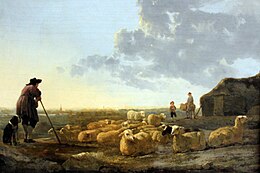
Cuyp's drawings reveal him to be a draftsman of superior quality. Light-drenched washes of golden brown ink depict a distant view of the city of Dordrecht or Utrecht.
A Cuyp drawing may look like he intended it to be a finished work of art, but it was most likely taken back to the studio and used as a reference for his paintings. Often the same section of a sketch can be found in several different pictures.
Cuyp signed many of his works but rarely dated them, so that a chronology of his career has not been satisfactorily reassembled. A phenomenal number of paintings are ascribed to him, some of which are likely to be by other masters of the golden landscape, such as Abraham Calraet (1642–1722), whose initials A.C. may be mistaken for Cuyp's.
However, not everyone appreciates his work and River Landscape (1660), despite being widely regarded as amongst his best work, has been described as having "chocolate box blandness".
At the Madrid's Thyssen-Bornemisza Museum most likely, the sole Cuyp's painting in Spanish public collections can be seen, a Landscape with a sunset ca. 1655 with animals.
Misattribution of paintings
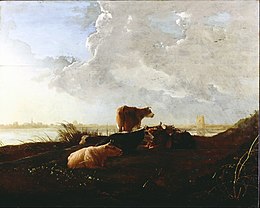
In addition to the scarcely documented and confirmed biography of Cuyp's life, and even more so than his amalgamated style from his three main influences, there are yet other factors that have led to the misattribution and confusion over Aelbert Cuyp's works for hundreds of years. His highly influenced style which incorporated Italianate lighting from Jan Both, broken brush technique and atonality from Jan van Goyen, and his ever-developing style from his father Jacob Gerritsz Cuyp was studied acutely by his most prominent follower, Abraham van Calraet. Calraet mimicked Cuyp's style, incorporating the same aspects, and produced similar landscapes to that of the latter. This made it quite difficult to tell whose paintings were whose. Adding to the confusion is the similar initials between the two and the inconsistent signing of paintings which were produced by Cuyp's studio.
Although Aelbert Cuyp signed many of his paintings with a script "A. Cuyp" insignia, many paintings were left unsigned (not to mention undated) after being painted, and so a similar signature was added later on, presumably by collectors who inherited or discovered the works. Furthermore, many possible Cuyp paintings were not signed but rather initialed "A. C." referring to his name. However, Abraham van Calraet could also have used the same initials to denote a painting. Although this is unlikely (as Calraet would likely have signed his paintings "A. v.C."), this brings up the question of how paintings were signed to show ownership. Most original Cuyp paintings were signed by him, and in the script manner in which his name was inscribed. This would denote that the painting was done almost entirely by him. Conversely, paintings which came out of his workshop that were not necessarily physically worked on by Cuyp but merely overseen by him technically, were marked with A.C. to show that it was his instruction which saw the paintings' completion. Cuyp's pupils and assistants often worked on paintings in his studio, and so most of the work of a painting could be done without Cuyp ever touching the canvas, but merely approving its finality. Hence, the initialed inscription rather than a signature.
Common among the mislabeled works are all of the reasons identified for misattributing Cuyp's works: the lack of biography and chronology of his works made it difficult to discern when paintings were created (making it difficult to pinpoint an artist); contentious signatures added to historians' confusion as to who actually painted the works; and the collaborations and influences by different painters makes it hard to justify that a painting is genuinely that of Aelbert Cuyp; and finally, accurate identification is made extremely difficult by the fact that this same style was copied (rather accurately) by his predecessor. As it turns out, even the historians and expert researchers have been fooled and forced to reassess their conclusions over "Cuyp's" paintings over the years.
Later life
After he married Cornelia Boschman in 1658, the number of works produced by him declined almost to nothing. This may have been because his wife was a very religious woman and a not very big patron of the arts. It could also be that he became more active in the church under his wife's guidance. He was also active as deacon and elder of the Reformed Church.
Legacy
Though long lacking a modern biography, and with the chronology of his works rather unclear, his style emerged from various influences and makes his works distinctive, although his collaborations with his father and works by his imitators often make attributions uncertain. His follower Abraham van Calraet represents a particular problem, and the signatures on paintings are not to be relied on. The Rijksmuseum has reattributed many works to other painters; Abraham van Calraet does not even appear in a Museum catalogue until 1926, and even then he was not given his own entry.
Gallery
- Aelbert Cuyp's paintings
-
 Landscape with cattle
Landscape with cattle
(c. 1639–1649)
National Gallery of Victoria -
 A View of the Maas at Dordrecht
A View of the Maas at Dordrecht
(about 1645–1646)
J. Paul Getty Museum -
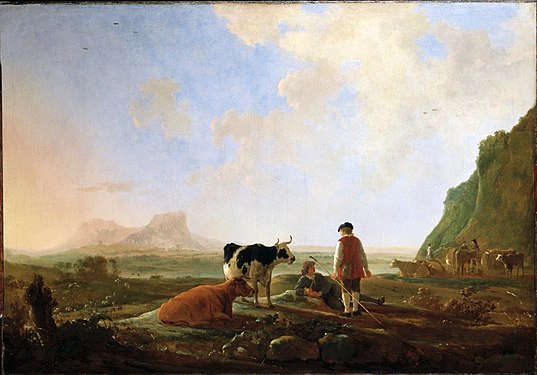 Herdsmen with Cows
Herdsmen with Cows
(c. 1645)
Dulwich Picture Gallery -
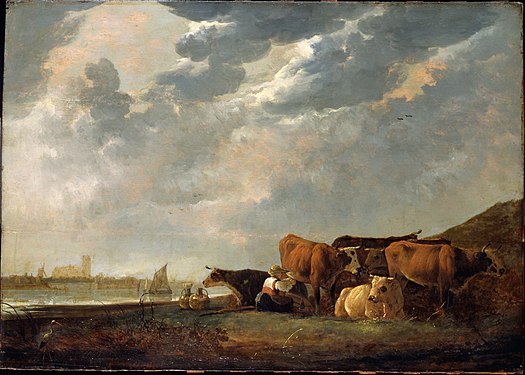 Cattle near the Maas, with Dordrecht in the distance
Cattle near the Maas, with Dordrecht in the distance
-
 Avenue at Meerdervoort
Avenue at Meerdervoort
-
 The Mussel Eater, c. 1650, Museum Boijmans Van Beuningen
The Mussel Eater, c. 1650, Museum Boijmans Van Beuningen
-
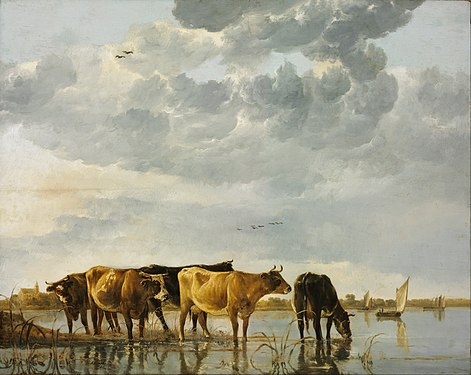 Cows in a River, c. 1654
Cows in a River, c. 1654
-
 Landscape with a Horseman, Figures, and Cattle, c. 1655, Waddesdon Manor
Landscape with a Horseman, Figures, and Cattle, c. 1655, Waddesdon Manor
-
 A Landing Party on the Maas at Dordrecht, 1655–1660, Waddesdon Manor. The other canvas that appears to show an event in the end stages of the Eighty Years' War is now in the National Gallery of Art, Washington.
A Landing Party on the Maas at Dordrecht, 1655–1660, Waddesdon Manor. The other canvas that appears to show an event in the end stages of the Eighty Years' War is now in the National Gallery of Art, Washington.
-
 Travelers in Hilly Countryside (c. 1650), Cleveland Museum of Art
Travelers in Hilly Countryside (c. 1650), Cleveland Museum of Art
-
 Equestrian Portrait of Cornelis and Michiel Pompe van Meerdervoort with Their Tutor and Coachman (before 1653), Metropolitan Museum of Art
Equestrian Portrait of Cornelis and Michiel Pompe van Meerdervoort with Their Tutor and Coachman (before 1653), Metropolitan Museum of Art
Notes
- In isolation, Aelbert and Jacobszoon are pronounced [ˈɑlbərt] and [ˈjaːkɔpsoːn], respectively.
References
- Pioch, Nicholas (14 July 2002). "Cuyp". WebMuseum, Paris. Archived from the original on 29 April 2007. Retrieved 19 April 2007.
- "Aelbert Cuyp". The Vincent van Gogh Gallery. Retrieved 14 April 2007.
- Adams, Ann Jensen; Sutton, Peter C. (June 1992). "Masters of Dutch 17th-Century Landscape Painting". The Art Bulletin. 74 (2): 334. doi:10.2307/3045877. ISSN 0004-3079. JSTOR 3045877.
- Wheelock, Arthur K., Jr., Aelbert Cuyp, (2001), p. 16
- Reiss (1975), p. 7
- Arnold Houbraken, De groote schouburgh der nederlantsche konstschilders en schilderessen, (1718–1721), p. 198.
- ^ Reiss (1975), p. 8.
- Reiss (1975), p. 9.
- Kelly, Ned (18 March 2002). "Cuyp cake". New Statesman. Archived from the original on 30 September 2007. Retrieved 19 April 2007.
- "Landscape with a Sunset". Museo Nacional Thyssen-Bornemisza. Retrieved 8 November 2019.
- Reiss (1975), p. 10.
- "Aelbert Cuyp". National Gallery of Art. 2007. Archived from the original on 9 May 2008. Retrieved 25 October 2007.
- Riemsdijk, (1926), p. 47.
Further reading
- Stephen Reiss (1975). Aelbert Cuyp. Zwemmer. ISBN 9780302027356.
- Gerard Hoet; Catalogus of Naamlyst van Schildereyen; The Hague; 1752; vol. 2
- Jean-Baptiste Descamps; La Vie des peintres flamands, allemands et hollandois; Paris; ; 1753–1763; vol. 2, p. 80
- George Agar-Ellis; Catalogue of the principal pictures in Flanders and Holland, 1822; London; W. Nicol; 1826; p. 70
- John Smith; A Catalogue Raisonne of the Works of the most Eminent Dutch, Flemish and French Painters Part III Containing the Lives and Works of Anthony Van Dyck and David Teniers; London; Smith and Son; 1831; vol. 5, no. 13
- Willem Bürger; Trésors d'Art exposés à Manchester en 1857; Paris; Jules Renouard et Cie; 1857; p. 266
- Jan F. van Someren; Oude Kunst in Nederland: Etsen van Willem Steelink; Amsterdam; ; 1890; pl. 3
- Emile Michel, Une famille d'artistes hollandais: Les Cuyps, Gazette des Beaux-Arts, 34, 1892, 5–23, 107–17, 224–38; p. 227
- Cornelis Hofstede de Groot; A Catalogue Raisonné of the Works of the Most Eminent Dutch Painters of the Seventeenth Century. Vols 1–4 ; Bishops Stortford; Chadwick Healey; 1976; vol. 2, no. 36
- Simon van Gijn; Dordracum Illustratum; Dordrecht; De Dordrechtsche Drukkerij-en Uitgevers-Maatschappij; 1908; no. 325
- Eugène Fromentin; The Masters of Past Time: Dutch and Flemish Painting from Van Eyck to Rembrandt ; Oxford; Phaidon Press; 1981; p. 149
- Sir Francis Watson, The Art Collections at Waddesdon Manor I: The Paintings, Apollo, 69, June 1959, 172–182; p. 181
- Christopher White, Dutch and Flemish Paintings at Waddesdon Manor, Gazette des Beaux-Arts, 54, August 1959, 67–74; p. 68
- Ellis Waterhouse, Anthony Blunt; Paintings: The James A. de Rothschild Collection at Waddesdon Manor; Fribourg; Office du Livre, The National Trust; 1967; pp. 134–135, cat. no. 55
- J Q Van Regteren Altena, Review of The James A. de Rothschild Collection at Waddesdon Manor. Ellis Waterhouse, Paintings., Oud Holland, 85, 1970, 59–61; p. 60
- S. Reiss; Aelbert Cuyp; London; Zwemmer; 1975; p. 146, no. 106
- Margarita Russell, Aelbert Cuyp. The Maas at Dordrecht: The Great Assembly of the Dutch Armed Forces, June–July 1646., Dutch Crossing, 40, 1990, 31–82; pp. 34–35
- Ben Broos; Great Dutch Paintings from America; Zwolle; Waanders Publishers; 1990; p. 215
- Alan Chong; Aelbert Cuyp and the Meanings of Landscape; New York University; 1992; p. 408, cat. no. 160; as 'The gathering of the fleet at Dordrecht'
- Arthur K Wheelock Jr.; Dutch Paintings of the Seventeenth Century: The National Gallery of Art's Systematic Catalogue; Washington, D.C.; National Gallery of Art; 1995; p. 129
- Ruud Priem, The "Most Excellent Collection" of Lucretia Johanna van Winter: The Years 1809–22, with a Catalogue of the Works Purchased, Simiolus: Netherlands Quarterly for the History of Art, 25, 1997, 103–196; p. 118, fig. 19
- Ruud Priem, Catalogue of Old Master Paintings Acquired by Lucretia Johanna van Winter, 1809–22, Simiolus: Netherlands Quarterly for the History of Art, 25, 1997, 197–230; p. 219, no. 38
- Arthur K Wheelock Jr.; Aelbert Cuyp; National Gallery of Art, Washington, 7 October 2001 – 13 January 2002; National Gallery, London, 13 February – 12 May 2002; Rijksmuseum, Amsterdam, 7 June – 1 September 2002; New York; Thames & Hudson; 2001; pp. 146–149
- Wouter Th. Kloek; Aelbert Cuyp: Land, Water, Light; Amsterdam, Zwolle; Rijksmuseum, Amsterdam, Waanders Publishers; 2002; p. 30
- Michael Hall; Waddesdon Manor: The Heritage of a Rothschild House; New York; Harry N Abrams Inc; 2002; p. 88, ill.
- Ariane van Suchtelen, Arthur K Wheelock Jr.; Dutch Cityscapes of the Golden Age; Royal Picture Gallery Mauritshuis, The Hague, 11 October 2008 – 11 January 2009; National Gallery of Art, Washington, 1 February – 3 May 2009; Zwolle, Washington, D.C., The Hague; Waanders Publishers, National Gallery of Art, Royal Picture Gallery Mauritshuis, The Hague; 2008; p. 104, ill.
- Peter Hecht; 125 Jaar openbaar kunstbezit : met steun van de Vereniging Rembrandt; Zwolle; Waanders Publishers; 2008; pp. 12, 14, 209 n. 98
- Arthur K Wheelock Jr.; "Aelbert Cuyp/The Maas at Dordrecht/c. 1650", Dutch Paintings of the Seventeenth Century, NGA Online Editions, accessed December 07, 2014.; Washington, D.C.; National Gallery of Art; 2012
- Crowe, Joseph Archer (1911). "Cuyp s.v. Albert Cuyp" . In Chisholm, Hugh (ed.). Encyclopædia Britannica. Vol. 7 (11th ed.). Cambridge University Press. pp. 677–678.
External links
[REDACTED] Media related to Aelbert Cuyp at Wikimedia Commons
- 81 artworks by or after Aelbert Cuyp at the Art UK site
- Works and literature on Aelbert Cuyp
- Dutch and Flemish paintings from the Hermitage, an exhibition catalog from The Metropolitan Museum of Art (fully available online as PDF), which contains material on Cuyp (cat. no. 7)
- Aelbert Cuyp's artworks at Waddesdon Manor
| Aelbert Cuyp | |
|---|---|
| Paintings |
|
| Related |
|